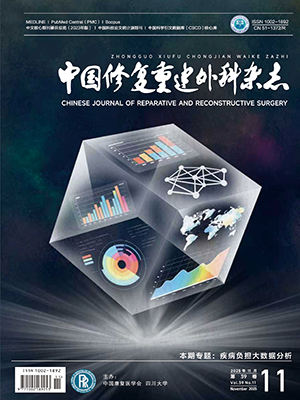Objective Epidermal stem cells (ESCs) can actively partici pate in wound heal ing and enhance reepithel ial ization. To establ ish ideal diabetes mell itus (DM) rat models and to investigate the expression of keratin 19 (K19),β1-integrin, β-catenin, and prol iferating cell nuclear antigen (PCNA) in ESCs of DM rat model, then to study the potential mechanism of difficult recovering wounds of diabetic skin. Methods Twenty male SD rats (weighing 250-300 g) were divided
into DM group and normal control group randomly (n=10). The DM rat model was made by intraperitoneal injected 65 mg/kg streptozocin (STZ), the normal control group was not treated. At 4 weeks after injection, pancreatic tissue was harvested for HE staining in two groups. The ESCs isolated from full-thickness skins of the back of two group rats were culutured and identified. The 2nd passage of ESCs were obtained for immunocytochemical staining of K19, β1-integrin, β-catenin, and PCNA. Meanwhile, the cell cycle were measured by flow cytometry. The cell colony formation rates were detected after 1 week. Results The achievement ratio of DM rat model was 90% with good stabil ity. HE staining showed that the number of islet cells significantly decreased with degeneration and necrosis in DM group; the structure of islet cell was clear without degeneration and necrosis in normal control group. The integral absorbance values of positive expression for K19, β1-integrin, β-catenin, and PCNA in ESCs of DM group (82.63 ± 14.77, 21.59 ± 4.71, 6.49 ± 6.58, and 90.77 ± 12.44, respectively) were significantly lower than those in the normal control group (151.24 ± 42.83, 54.48 ± 17.43, 116.39 ± 9.26, and 110.62 ± 20.67, respectively) (P lt; 0.01). The clone forming efficiency of ESCs in DM group (6.43% ± 1.01% ) was significantly lower than that in the normal control group (11.37% ± 1.62%) (P lt; 0.01). Flow cytometry indicated that 88.89% of cultured ESCs in the DM group were in resting state/ pre-DNA-synthetic gap (G0/G1), and the apoptosis rate was 3.98%; 91.50% in the normal control group and the apoptosis rate was 0. Conclusion The DM rat model can be effectively induced by intraperitoneal injected 65 mg/ kg STZ. The decreased amount and the low prol iferation and differentiation capacity of ESCs may be one of the important mechanisms of difficult recovering wounds of DM rats.
Citation: ZHONG Qingling,LIU Dewu,LIU Fanrong,PENG Yan,ZHANG Xiangrong,LAN Wei. STUDY ON RELATED PROTEINS OF PROLIFERATION AND DIFFERENTIATION OF EPIDERMAL STEM CELLS IN DIABETIC RATS. Chinese Journal of Reparative and Reconstructive Surgery, 2010, 24(2): 133-137. doi: Copy
Copyright © the editorial department of Chinese Journal of Reparative and Reconstructive Surgery of West China Medical Publisher. All rights reserved




